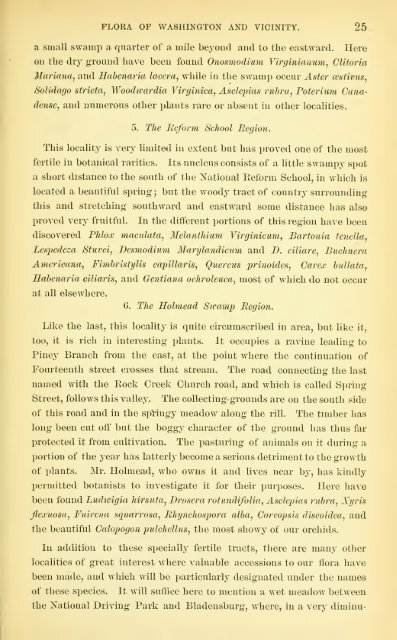Bulletin - United States National Museum - Smithsonian Institution
Bulletin - United States National Museum - Smithsonian Institution
Bulletin - United States National Museum - Smithsonian Institution
You also want an ePaper? Increase the reach of your titles
YUMPU automatically turns print PDFs into web optimized ePapers that Google loves.
FLORA OF WASHINGTON AND VICINITY. 25<br />
a small swamp a quarter of a mile beyond and to the eastward. Here<br />
on the dry ground have been found Onosmodium Virginianuin, Clitoria<br />
Mariana, and Habenaria lacera, while in the swaraiJ occur Aster wstivus,<br />
Solidago stricta, Woodwardia Virginica, Asclepias rubra, Poteriiim Cana-<br />
dense, and numerous other plants rare or absent in other localities.<br />
5. The Reform ScJiool Region.<br />
This locality is A^ery limited in extent but has proved one of the most<br />
fertile in botanical rarities. Its nucleus consists of a little swampy spot<br />
a short distance to the south of the <strong>National</strong> Eeform School, in which is<br />
located a beautiful spring ;<br />
but the woody tract of country surrounding<br />
this and stretching southward and eastward some distance has also<br />
proved very fruitful. In the different portions of this region have been<br />
discovered Phlox maculata, Melanthium Virginicum, Bartonia tenella^<br />
Lespedeza Stuvei, Besmodium Marylandicum and B. ciliare, Buchnera<br />
Americana, Fimbristylis capillaris, Quercus prinoides, Carex bullata,<br />
Habenaria eiliaris, and Gentiana ochroleuca, most of which do not occur<br />
at all elsewhere.<br />
6. The Holmead Swamp Region.<br />
Like the last, this locality is quite circumscribed in area, but like it,<br />
too, it is rich in interesting plants. It occupies a ravine leading to<br />
Piney Branch from the east, at the point where the continuation of<br />
Fourteenth street crosses that stream. The road connecting the last<br />
named with the Eock Creek Church road, and which is called S]>ring<br />
Street, follows this valley. The collecting- grounds are on the south side<br />
of this road and in the spl-ingy meadow along the rill. The timber has<br />
long been cut off but the boggy character of the ground has thus far<br />
protected it from cultivation. The pasturing of animals on it during a<br />
portion of the year has latterly become a serious detriment to the growth<br />
of plants. Mr. Holmead, who owns it and lives near by, has kindly<br />
permitted botanists to investigate it for their purposes. Here have<br />
been found Ludwigia hirsuta, Brosera rotundifoUa, Asclepias rubra, Xyris<br />
Jlexuosa, Fuirena squarrosa, Rhynchospora alba, Coreopsis discoidea, and<br />
the beautiful Calopogon pulchellus, the most showy of our orchids.<br />
In addition to these specially fertile tracts, there are many other<br />
localities of great interest where valuable accessions to our flora have<br />
been made, and which will be particularly designated under the names<br />
of these species. It will suffice here to mention a wet meadow between<br />
the i^ational Driving Park and Bladensburg, where, in a very diminu-

















